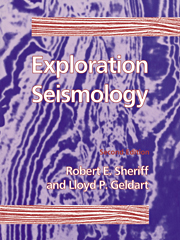Book contents
- Frontmatter
- Contents
- Preface
- Mathematical conventions and symbols
- 1 Introduction
- 2 Theory of seismic waves
- 3 Partitioning at an interface
- 4 Geometry of seismic waves
- 5 Seismic velocity
- 6 Characteristics of seismic events
- 7 Equipment
- 8 Reflection field methods
- 9 Data Processing
- 10 Geologic interpretation of reflection data
- 11 Refraction methods
- 12 3-D Methods
- 13 Specialized techniques
- 14 Specialized applications
- 15 Background mathematics
- Appendices
- Index
12 - 3-D Methods
Published online by Cambridge University Press: 05 June 2012
- Frontmatter
- Contents
- Preface
- Mathematical conventions and symbols
- 1 Introduction
- 2 Theory of seismic waves
- 3 Partitioning at an interface
- 4 Geometry of seismic waves
- 5 Seismic velocity
- 6 Characteristics of seismic events
- 7 Equipment
- 8 Reflection field methods
- 9 Data Processing
- 10 Geologic interpretation of reflection data
- 11 Refraction methods
- 12 3-D Methods
- 13 Specialized techniques
- 14 Specialized applications
- 15 Background mathematics
- Appendices
- Index
Summary
Overview
Seismic data are usually collected along lines of traverse that form some sort of grid and the three-dimensional (3-D) picture of structure is deduced by interpolating between the lines. However, features seen on such seismic lines may be located off to the side of the lines rather than underneath the lines and small but important features (like faults) can occur between the lines. These produce errors in interpretation. 3-D surveys endeavor to obtain data uniformly distributed over an area rather than merely along lines, in order to correctly locate the geologic features that produce the seismic evidences. 3-D techniques also significantly reduce spatial noise.
Although 3-D data are not inexpensive to acquire, process, or interpret, their value is becoming widely recognized, and 3-D is one of the fastest growing areas of geophysics. Much 3-D work involves the detailing of fields once oil has been discovered in order to optimize field development and exploitation (Dahm and Graebner, 1982; Galbraith and Brown, 1982), and 3-D has proven very cost effective in this regard. There is nearly unanimous agreement that 3-D surveys result in clearer and more accurate pictures of geologic detail. The costs are more than repaid by the elimination of unnecessary development holes and imprudent investments, by the increase in recoverable reserves through better location of production and injection wells, and by the discovery of isolated pools in a reservoir that otherwise might be missed.
- Type
- Chapter
- Information
- Exploration Seismology , pp. 451 - 470Publisher: Cambridge University PressPrint publication year: 1995



